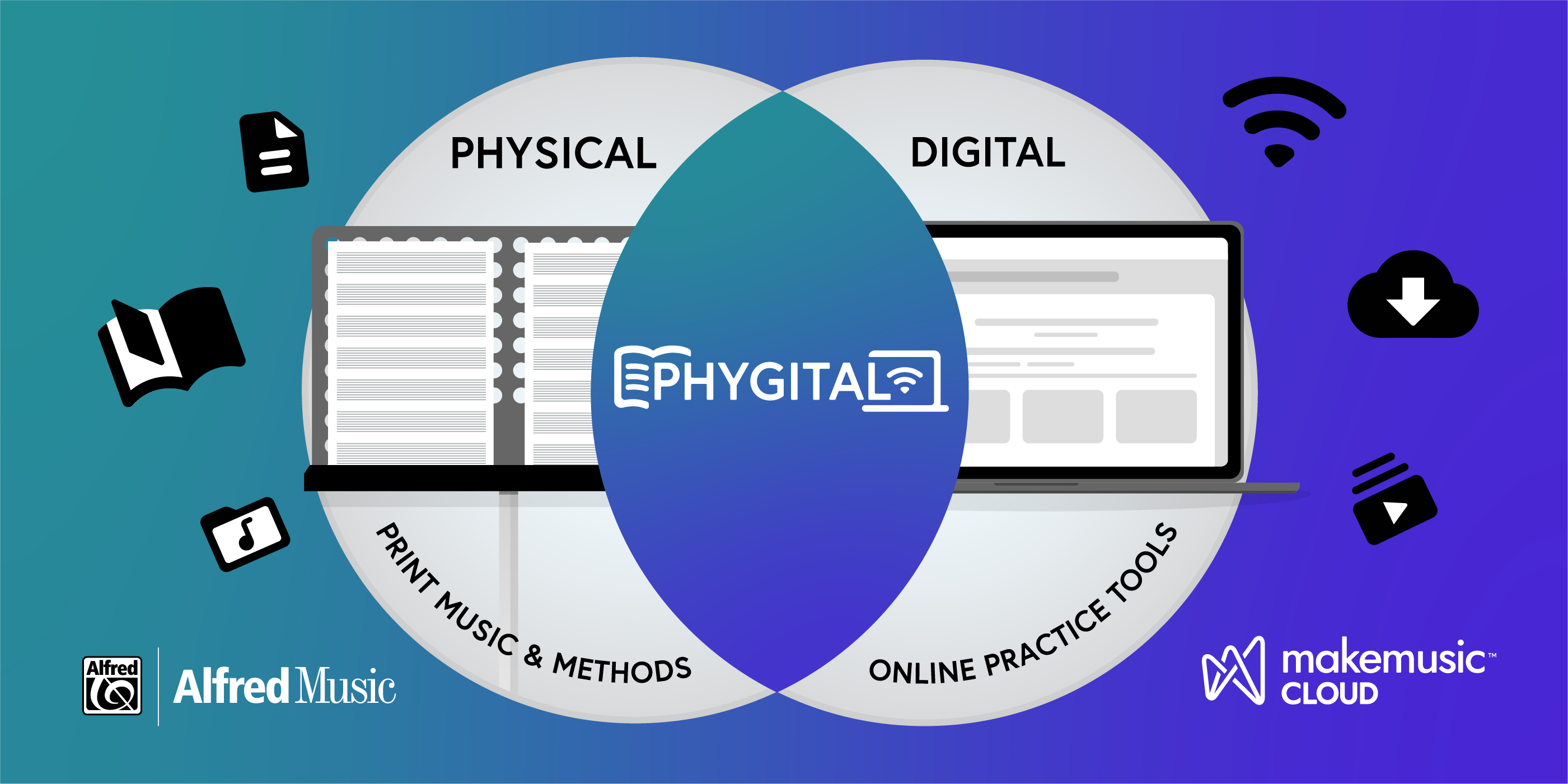
Music education is undergoing a transformation, adapting to the digital age while preserving its long-lasting traditions. Today, it’s not just about reading sheet music and practicing instruments; it’s a dynamic blend of traditional techniques and innovative technologies. The landscape of today’s music education now includes digital platforms, interactive resources, and collaborative tools that transcend physical boundaries. This shift is fostering a more inclusive approach, reaching students from diverse backgrounds and abilities.
At MakeMusic and Alfred Music, we’re calling this approach a Phygital Music Classroom. And while it’s a fun play on words, the philosophy is based on the belief that we can help more students experience the joy of making music if we can make the learning and practicing process fun and more meaningful. Before we get to the joy of making music, let’s define phygital.
phys·i·cal + dig·i·tal = phyg·i·tal
/ˈfijidl/
adjective
1. (physical plus digital) is the blending of physical books and sheet music with digital experiences to create a more powerful learning experience.
Leveraging the benefits of traditional physical books and sheet music with the advantages of digital technology truly combines the best of both worlds, creating a more powerful music learning environment. A Phygital music classroom offers students a more dynamic and enriched learning experience while preparing them for a world where technology plays an increasingly significant role in music creation and performance. Imagine kids being able to go deeper into the music they are playing. Imagine an opportunity where a student can experience their ensemble music in a completely new way. Imagine a world where the movie soundtracks of our lives become key motivators to solving one of our most basic wants – “I wish my kids would practice more.”
Well, we don’t have to imagine. That reality is here, in the form of a Phygital approach. Let’s look at six ways a Phygital approach can benefit the students in your classrooms by unlocking new experiences, challenging students in new ways, and reigniting a sense of joy for both practice and performance.
- Enhanced Engagement: By combining physical sheet music with digital tools, students can dive into an interactive world of music education. This immersive approach not only engages them but also enhances the learning experience, blending multimedia resources for a more enjoyable journey.
- Accessibility and Convenience: Digital tools are particularly useful due to their convenience and flexibility. With these tools, students can easily reach learning materials at their fingertips, whether they’re in the classroom, at home, or on the go, needing only a compatible device and an internet connection.
- Multi-Sensory Learning: Combining a digital tool with physical sheet music transforms learning by engaging students through various senses. They’re not only reading the text but also listening to audio examples, watching instructional videos, and actively participating in interactive exercises, creating a multi-dimensional learning experience.
- Differentiated Learning: Frequently, digital tools come with personalized learning capabilities that cater to individual student abilities and learning speeds. They offer customized practice exercises, track progress, and provide feedback, empowering students to learn at their own cadenceand concentrate on areas needing extra attention.
- Expanded Repertoire: Pairing your physical music library with a digital catalog opens up boundless opportunities for students to uncover and delve into new music. They have the chance to venture into uncharted musical genres, discover fresh compositions by beloved composers, and even contribute to curating their dream concert lineup.
- Creation and Collaboration Opportunities: Incorporating technology can unite students through composition, diverse musical styles, and shared interests. It opens up limitless opportunities for students to channel their creativity, foster a sense of community, and encourage students to learn from and support each other.
When I joined Alfred Music and MakeMusic over a year ago, I shared that a key reason was because I saw the musical world accelerating toward a digital ecosystem. I wanted to be part of that journey, and wanted to be able to engage in meaningful conversations about how the digital world can positively impact the music community. The truth is that an all-digital approach is not the answer. As someone who experiences the sheer joy of stepping on a podium in a physical space with a physical score, I appreciate the ability to feel the music under my fingers. But I am also equally excited about the digital tools we are developing, which are just a click away from unlocking new, exciting experiences for our students. Physical + digital doesn’t just mean Phygital – it means joy. Phygital solutions seamlessly blend these physical and digital resources, providing an elevated learning experience and a more comprehensive and well-rounded music education. Who says the world is at your fingertips? Why not have both worlds at your fingertips?!
Want to try out the Phygital approach with your students? Start a free 30-day trial here, or request a demo with one of our specialists today!
Interested in learning more? For those attending the Midwest Clinic, come see Brian Balmages present all about the Phygital Musician. THURSDAY, DECEMBER 21st at 1:00pm in Room W180.
